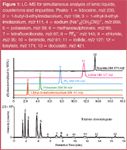LC–MS Analysis of Ionic Liquids, Counterions and Impurities Using the Trimode Acclaim Trinity P1 Column
The Application Notebook
The term ionic liquid refers to organic salts with relatively low melting points (below 100 °C) that usually consist of an organic cation or anion and a counterion, in either organic or inorganic form.
The term ionic liquid refers to organic salts with relatively low melting points (below 100 °C) that usually consist of an organic cation or anion and a counterion, in either organic or inorganic form. Ionic liquids exhibit unique characteristics such as extremely low vapour pressure, excellent thermal stability, electrical conductivity, a high degree of polarity and miscibility with various types of solvents. Ionic liquids have been used as catalysts and solvents in organic chemistry and electrochemistry and as mobile phase modifiers or functionalized stationary phases in separation science.1–3
Analytical methods for ionic liquid characterization are challenging because of the complexity of the cationic or anionic organic ions, counterions and ionic impurities. Ion chromatography (IC), liquid chromatography (LC) and hydrophilic interaction chromatography (HILIC) have been used for ionic liquid analysis, featuring ion-exchange or reversed-phase columns.4–6
This study describes the first LC–MS method for the simultaneous analysis of ionic liquids, counterions and halide impurities in a single chromatographic run on an Acclaim Trinity P1 trimode column, using mass spectrometry to ensure selective and sensitive detection.
The experiment was performed on an LC–MS system consisting of an UltiMate 3000 HPLC system coupled to a MSQ Plus single quadrupole mass spectrometer with electrospray ionization interface. Chromatographic separation was achieved on an Acclaim Trinity P1 column (2.1 × 100 mm, 3 μm) with a gradient elution: A: acetonitrile; B: 100 mM ammonium acetate, pH 5.2; C: DI water. B was kept constant at 5%, A was increased from 55% (2 min) to 60% in 8 min then 90% in 1 min and kept at 90% for 7 min.
MSQ Plus was operated in selected ion monitoring (SIM) mode and probe temperature was set at 500 °C, nitrogen was used as nebulizer gas at 85 psi and needle voltage was set at 1 kV.
As shown in Figure 1, ionic liquids, counterions and impurities were chromatographically separated on the Acclaim Trinity trimode column. Analytes were eluted in groups in the following order: organic cations, inorganic cations, inorganic anions and organic anions. The upper traces in Figure 1 show the SIM chromatograms of selected analytes, illustrating the specificity and selectivity of the MSQ Plus detector.

Figure 1
Conclusion
This study demonstrates the unique properties and superior chromatographic performance of the Acclaim Trinity trimode column and its application for simultaneous analysis of ionic liquids, counterions and impurities. This method can be used for ionic liquid quality assurance, contamination analysis and residue assessment of any removal process.
References
1. Z. Yang and W. Pan, Enzyme and Microbial Tech., 37, 19–28 (2005).
2. C.B. Marisa, G.E. Russell and G.C. Richard, Chem. Phys. Chem., 5, 1106–1120 (2004).
3. J.L. Anderson and D.W. Armstrong, Anal. Chem., 75, 4851–4858 (2003).
4. A. Stojanovic et al., J. Chromatogr. A, 1209, 179–187 (2008).
5. G. Le Rouzo et al., J. Chromatogr. A, 1164, 139–144 (2007).
6. F. Hao, P.R. Haddad and T. Ruther, Chromatographia, 495–498 (2008).
Trinity is a trademark and Acclaim and UltiMate are registered trademarks of Dionex Corporation.
MSQ Plus is a trademark of Thermo Fisher Scientific Inc.

Dionex Corporation
1228 Titan Way, PO Box 3603, Sunnyvale
California 94088, USA
tel. +1 408 737 0700 fax +1 408 730 9403
Website: www.dionex.com

Analyzing Vitamin K1 Levels in Vegetables Eaten by Warfarin Patients Using HPLC UV–vis
April 9th 2025Research conducted by the Universitas Padjadjaran (Sumedang, Indonesia) focused on the measurement of vitamin K1 in various vegetables (specifically lettuce, cabbage, napa cabbage, and spinach) that were ingested by patients using warfarin. High performance liquid chromatography (HPLC) equipped with an ultraviolet detector set at 245 nm was used as the analytical technique.
Removing Double-Stranded RNA Impurities Using Chromatography
April 8th 2025Researchers from Agency for Science, Technology and Research in Singapore recently published a review article exploring how chromatography can be used to remove double-stranded RNA impurities during mRNA therapeutics production.
The Effect of Time and Tide On PFAS Concentrations in Estuaries
April 8th 2025Oliver Jones and Navneet Singh from RMIT University, Melbourne, Australia discuss a recent study they conducted to investigate the relationship between tidal cycles and PFAS concentrations in estuarine systems, and offer practical advice on the sample preparation and LC–MS/MS techniques they used to achieve the best results.
Assessing Safety of Medications During Pregnancy and Breastfeeding with LC–MS/MS
Published: April 8th 2025 | Updated: April 8th 2025Researchers conducted a study on medications used in psychiatry and neurology during the perinatal period, assessing how antiepileptic drugs (AEDs) affect placental functions, including transport mechanisms, nutrient transport, and trophoblast differentiation. Several quantitative methods, such as those for antianxiety and hypnotic drugs, were established to evaluate the safety of pharmacotherapy during breastfeeding using liquid chromatography-tandem mass spectrometry (LC–MS/MS).



















